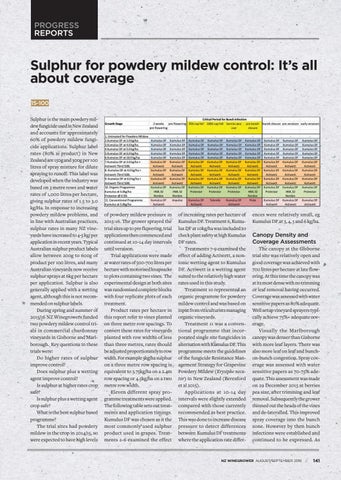PROGRESS REPORTS
Sulphur for powdery mildew control: It’s all about coverage 15-100 Sulphur is the main powdery mildew fungicide used in New Zealand and accounts for approximately 60% of powdery mildew fungicide applications. Sulphur label rates (80% ai product) in New Zealand are 150g and 300g per 100 litres of spray mixture for dilute spraying to runoff. This label was developed when the industry was based on 3 metre rows and water rates of 1,000 litres per hectare, giving sulphur rates of 1.5 to 3.0 kg/Ha. In response to increasing powdery mildew problems, and in line with Australian practices, sulphur rates in many NZ vineyards have increased to 4-5 kg/ per application in recent years. Typical Australian sulphur product labels allow between 200g to 600g of product per 100 litres, and many Australian vineyards now receive sulphur sprays at 6kg per hectare per application. Sulphur is also generally applied with a wetting agent, although this is not recommended on sulphur labels. During spring and summer of 2015/16 NZ Winegrowers funded two powdery mildew control trials in commercial chardonnay vineyards in Gisborne and Marlborough. Key questions in these trials were: Do higher rates of sulphur improve control? Does sulphur plus a wetting agent improve control? Is sulphur at higher rates crop safe? Is sulphur plus a wetting agent crop safe? What is the best sulphur based programme? The trial sites had powdery mildew in the crop in 2014/15, so were expected to have high levels
of powdery mildew pressure in 2015-16. The grower sprayed the trial sites up to pre flowering, trial applications then commenced and continued at 10-14 day intervals until veraison. Trial applications were made at water rates of 500-700 litres per hectare with motorised knapsacks to plots containing two vines. The experimental design at both sites was randomised complete blocks with four replicate plots of each treatment. Product rates per hectare in this report refer to vines planted on three metre row spacings. To convert these rates for vineyards planted with row widths of less than three metres, rates should be adjusted proportionately to row width. For example 3kg/ha sulphur on a three metre row spacing is equivalent to 3.75kg/ha on a 2.4m row spacing or 4.5kg/ha on a two metre row width. Eleven different spray programme treatments were applied. The following table sets out treatments and application timings. Kumulus DF was chosen as it the most commonly used sulphur product used in grapes. Treatments 2-6 examined the effect
of increasing rates per hectare of Kumulus DF. Treatment 6, Kumulus DF at 10kg/ha was included to check plant safety at high Kumulus DF rates. Treatments 7-9 examined the effect of adding Actiwett, a nonionic wetting agent to Kumulus DF. Actiwett is a wetting agent suited to the relatively high water rates used in this study. Treatment 10 represented an organic programme for powdery mildew control and was based on input from viticulturists managing organic vineyards. Treatment 11 was a conventional programme that incorporated single site fungicides in alternation with Kumulus DF. This programme meets the guidelines of the fungicide Resistance Management Strategy for Grapevine Powdery Mildew (Erysiphe necator) in New Zealand (Beresford et al 2015). Applications at 10-14 day intervals were slightly extended compared with those currently recommended as best practice. This was done to increase disease pressure to detect differences between Kumulus DF treatments where the application rate differ-
ences were relatively small, eg Kumulus DF at 3, 4, 5 and 6 kg/ha.
Canopy Density and Coverage Assessments The canopy at the Gisborne trial site was relatively open and good coverage was achieved with 700 litres per hectare at late flowering. At this time the canopy was at its most dense with no trimming or leaf removal having occurred. Coverage was assessed with water sensitive papers as 80% adequate. Well setup vineyard sprayers typically achieve 75%+ adequate coverage. Visually the Marlborough canopy was denser than Gisborne with more leaf layers. There was also more leaf on leaf and bunchon-bunch congestion. Spray coverage was assessed with water sensitive papers as 70-75% adequate. This assessment was made on 29 December 2015 at berries pea size, after trimming and leaf removal. Subsequently the grower thinned out the heads of the vines and de-lateralled. This improved spray coverage into the bunch zone. However by then bunch infections were established and continued to be expressed. As
NZ WINEGROWER AUGUST/SEPTEMBER 2016 // 141
